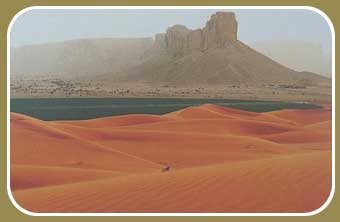| |

©Fred Hoogevorst/Panos
Pictures |
As one of the driest countries
on earth, much of Saudi Arabia is a harsh environment. There
are vast plains of gravel, salt flats and sandy desert, and
there are no permanent rivers, streams or lakes.
The Rub al Khali (‘the
empty quarter’) in south-east Saudi Arabia is the world’s
largest continuous sand desert. Here, it can be a baking 55°C
during the day but clear skies at night cause temperatures
to plummet. It is very dry too. Ten years can go by between
rain showers in Rub al Khali.
The
capital city, Riyadh is surrounded by desert.
 to see a graph that shows the average climate of Riyadh, and
a drag and drop activity.
to see a graph that shows the average climate of Riyadh, and
a drag and drop activity.
Elsewhere in Saudi Arabia,
higher altitudes influence the climate. In the south-west
corner where the rugged mountain peaks of the Asir Highlands
reach over 3,000 metres, temperatures average 19°C. Between
May and October, monsoon
winds bring enough rain to support some grasses and small
trees, and irrigate farmers’ terraced fields high on
the mountain slopes.
 |
With
so much of the country covered in desert, water is in
short supply. Underground reserves in aquifers
are drying up and Saudis are looking for sustainable
alternatives. Click on the icons below to find out about
two of these alternatives.
|
|
|





